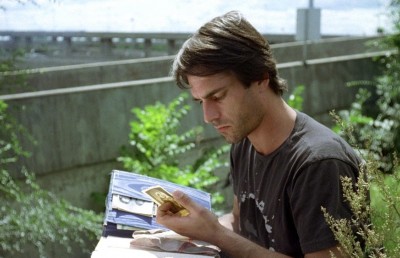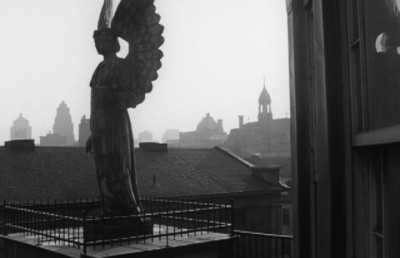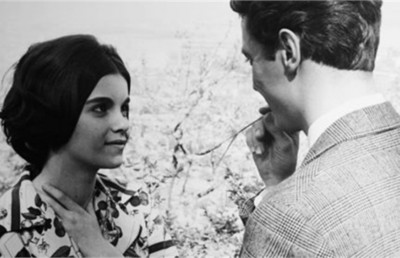Lonely Boy: Documenting the Manufacture of a Pop Idol
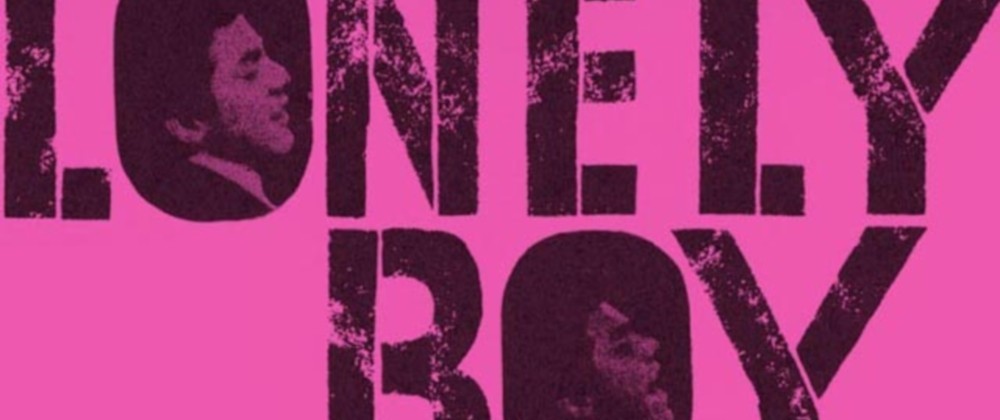
The 1962 documentary Lonely Boy, directed by Wolf Koenig and Roman Kroitor, is a film about the manufacture of a pop idol. Paul Anka, the subject of the documentary, is a popular performer at the peak of his career, but the directors use a variety of strategies to express their view of him as an isolated figure who is seen by his handlers as a piece of merchandise and whose success is questionable. They do this through interviews which focus on the process of Anka’s rise, frequent references to the merchandising operation he is at the center of, editing that highlights the freakishness and hysteria of his fans, and frequent shots that emphasize his isolation. Several other films made in the 1960s dealt with the phenomenon of celebrity in the same cinema vérité style, and examining how the editing choices made by Koenig and Kroitor differ from films such as Primary (Robert Drew, 1960), What’s Happening! The Beatles In the U.S.A. (Albert and David Maysles, 1964) and Don’t Look Back (D.A. Pennebaker, 1967) is useful in illustrating the directors’ skeptical view of the celebrity machine and the idea that despite Anka’s success, Lonely Boy can be seen as yet another Canadian film about failure.
According to Peter Harcourt, the filmmakers saw Anka as a “tragic figure.” [1] In some ways this is odd, since at 19 years old Anka was a lot richer and a good deal more famous than either Koenig or Kroitor would ever be. In 1961, he was a phenomenon, the biggest pop star Canada had ever had. He had had eight top 10 singles since 1957, including the number one hit “Lonely Boy” [2] and “Diana,” which since its release in 1957 had reportedly been covered by over 300 artists and sold 10 million copies worldwide. [3] Though generally associated with the “Philadelphia teen idols” of the period such as Fabian, Frankie Avalon and Bobby Rydell (so called not because they were from Philadelphia, but because they were promoted through Dick Clark’s American Bandstand, a TV show broadcast out of Philadelphia), he was much more popular, and seen as “a genuine musical prodigy” who wrote his own songs and had a “flair for show business.” [4] Besides his own material, he also wrote “It Doesn’t Matter Any More,” a hit for Buddy Holly. The film itself seems to document a successful tour, with Anka performing to enthusiastic audiences and being mobbed by hysterical fans. Given this, it isn’t too surprising that even a modern audience unaware of how big a star Anka was might entirely miss any hint of tragedy. As Harcourt writes, “in documentary, the apparent subject-matter tends to overwhelm the statement contained within the treatment.” But it is through this treatment, the decisions concerning what issues are examined and how they are presented, that the filmmakers express themselves. [5]
Early on, a narrator states the film’s interest is in Anka’s transformation from “an entertainer into an idol.” The process of this transformation is sketched out when Anka talks frankly of his belief that to become the type of star he wanted to be, he “had to look like he was in show business.” He details his losing 35 pounds and spending over a year to shape his hair. Later, his manager Irvin Feld, after a dispassionate discussion of Anka’s facial features, mentions Anka had a nose job and states bluntly that it would be impossible to recognize him from photographs taken just a couple of years before. Feld then discusses his strategy of “grooming” Anka for a move away from his current teen audience to an older nightclub audience. What is interesting about this is less the details of Anka’s transformation than the film’s focus on them. The subjects of Primary (John F. Kennedy), What’s Happening! (The Beatles) and Don’t Look Back (Bob Dylan) were also, to some extent, manufactured celebrities who adopted personas to achieve stardom. But those films, similar to Lonely Boy in many other ways, largely ignore this question.
The emphasis on merchandising is another thread that runs through the film. After the narrator states the interest in Anka’s “transformation,” the film then cuts immediately to a shot of hawkers selling concert programmes. Scenes with Anka fans invariably feature them with their arms full of Anka-related product. One teenage fan declares she has 555 pictures of Anka on her bedroom wall. When Anka talks briefly with another fan outside a theatre, he looks at all her souvenirs and is moved to remark “It looks like you have everything, don’t you?” Feld’s willingness to straightforwardly discuss Anka’s looks and his marketing strategies to promote him suggest that Anka’s transformation into an idol has made him a product to be sold as much as the records and other souvenirs. The sequence whose editing makes this point most clearly shows Anka walking with his entourage along the Atlantic City boardwalk, cuts to a close-up of a monster puppet in a sideshow, then cuts immediately to a close-up of an autographed Anka postcard. The pop star with his entourage waving to his adoring fans is in this way directly compared to a puppet and a piece of merchandise. Pop star merchandising is not unusual, and What’s Happening! also has shots of young fans buying Beatles albums and holding Beatles merchandise, but these are not foregrounded so deliberately nor repeated as often as they are in Lonely Boy, and there is never any juxtaposition of shots as suggestive as the puppet-postcard sequence. When Feld talks of telling Anka “Paul, you don’t belong to yourself anymore, you belong to the world,” he isn’t kidding.
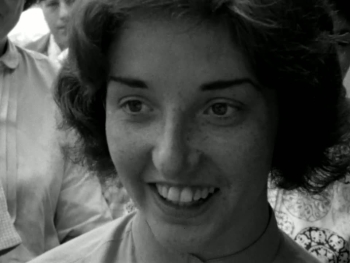
Fan with 555 photos of Anka on wall
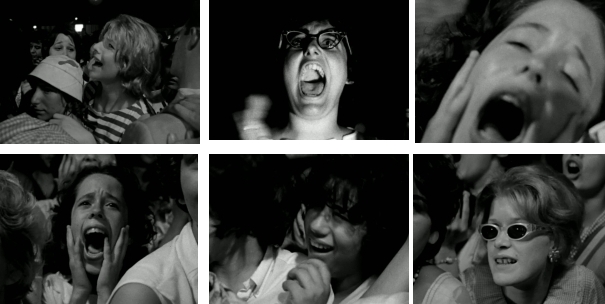
Montage of Female Teen Ankamania
That Anka is compared to a monster puppet in that sequence reinforces another aspect of the film, the highlighting of the freakishness of his audience. While it is possible that Anka’s fan base was heavily weighted with homely teenage girls, it is more likely the highlighting of less attractive faces was an editing choice. In a scene where Anka fans line up for autographs and kisses, the focus is on a girl whose eyes cross when he kisses her cheek. Of the fans interviewed in the queue, one has what looks like dyed blonde hair and raccoonish eye makeup. The previously mentioned girl with 555 Anka photos has prominent buck teeth, while the girl visible behind her shoulder looks like a character drawn by Matt Groening. Later, as Anka sings “My Hometown,” there is a shot of a screaming, chunky brunette, followed by an equally chunky brunette with Buddy Holly glasses, and then another brunette with glasses. The camera stays straight on this one for a few seconds, the focus of the shot being her wide open screaming mouth and tongue. At another point, while Anka talks about his fans, there is a cut to a heavy girl with big hair and arms full of Anka merchandise, the camera then pans left to another girl with big hair and arms full of Anka merchandise – wearing the same outfit. During the Dreamland sequence, the camera stays in a cruel close-up of the sweating and quivering face of the young fan brought up to the stage for Anka to sing “Put Your Head On My Shoulder” to. The emphasis in these shots is on the grotesqueness of his fans. It is no wonder the policeman, when asked if the mob of fans scares him, says “it’s Paul Anka that should be scared.”
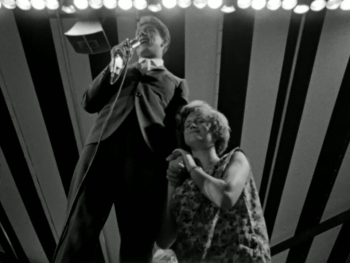
An interesting comparison is Primary, in which John F. Kennedy has to deal with crowds nearly as large and intense as Anka’s. They don’t scream, but there is a sequence where the camera follows behind Kennedy as he plunges through an adoring crowd and hands reach out to touch him that brings the pop star documentaries strongly to mind. As he speaks at the film’s climactic rally, the camera pans the crowd, which is singing the campaign song “High Hopes,” and lingers on an attractive blonde, who smiles at her neighbour, and then moves to settle on another attractive blonde. There were certainly less striking faces in the crowd, but focusing on the attractive and well dressed is a way of shaping the viewer’s perception of the crowd (and of the candidate/pop star who the crowd is watching). In What’s Happening!, the Beatles face mobs much larger and wilder than Anka ever dreamed of, but again, they seem less grotesque than those in Lonely Boy. This is partly due to a viewer’s retrospective knowledge that the Beatles’ music has lasted in a way that Paul Anka’s hasn’t, and there really was something for them to get excited about. But it is also because the Maysles’ cameras focus on the mix of people in the crowds, and is as likely as not to pick out a strikingly attractive face, such as the girl singing along on “I Saw Her Standing There” at the Washington, D.C. concert.
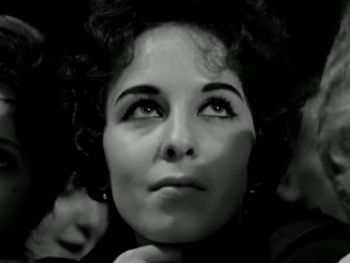
Exception to the rule: attractive girl with the hungry eyes
Harcourt suggests that another strategy used in the film is to “have it full of shots that make us feel that something is going wrong,” citing a photographer whose flashbulb refuses to work. [6] This seems overstated, since it is a comic moment and the only time in the film that something doesn’t work. Even the same photographer is shown later in the film, taking a successful photograph. Harcourt also writes that the filmmakers are “respectful towards Anka’s talent,” but while the audiences are shown to be uniformly, even overwhelmingly, appreciative of Anka, the filmmakers seem less so. Most of the songs are reduced to snippets, and the camera rarely spends time on Anka when he is performing, preferring to explore the crowd. There is no equivalent to the D.C. concert scenes in What’s Happening! or the sequence in Don’t Look Back where the camera remains on Dylan’s face in close-up as he sings “The Lonesome Death of Hattie Carroll.” Later, when Anka is showed rehearsing a new song, the sound of his voice fades and is replaced by a voiceover of the manager. The message seems to be that Anka’s audience is more interesting than Anka, and that his talent is less important than how he is marketed.
Along with the marginalization of his talent, there are several sequences which suggest his isolation. The most notable is when Anka strips down to his underwear while everyone else in the room remains fully clothed. On stage, of course, he is always alone and almost always shot in low angle from below. Even when a girl is brought on stage for him to sing to, he towers over her. At the end of the movie, the camera cuts to a close-up of his tired face as his flunkies chatter around him about next year’s tour, alone and disconnected from the people around him. It is interesting that while the film shows Anka composing his own material and giving instructions to the orchestra, it is Feld who at the end is telling him where he will tour, what kind of orchestra he will have and how he will use them. Anka may be the engine that powers the machine, but Feld is the driver. What is also important is the continuing presence of Anka’s entourage. He has flunkies to find his clothes when he needs to dress in a hurry, massage his neck during a long car ride or listen adoringly while he plays his new song, but he doesn’t seem to have any friends or family around. Except for a brief sequence of Anka on a bumper car (which also not so subtly infantilizes him), he is never shown relaxing or having fun. There is nothing to match the sight of the Beatles dancing and drinking with hot babes on their laps at the Peppermint Lounge (and later sneaking a girl back to their hotel room) or of Dylan hanging out and jamming with folkies and bohemians in all night parties. It is certainly possible that Anka had a sex life (even if he is embarrassed to even say the word “sex”), but that’s not what the filmmakers show us. Even more insidious, there is nobody around Anka to tell him anything he doesn’t want to hear. All he seems to have is Feld, who calls Anka “the greatest talent in the last 500 years” and predicts he will be the “greatest star” in the history of show business. It is a wonder that anybody fed a constant diet of that since they were 15 hadn’t turned into a monster.
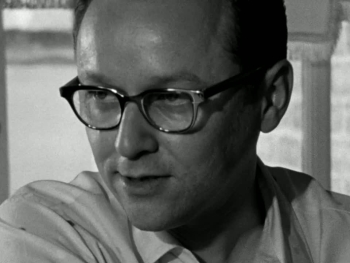
Manager Irvin Feld
In fact, Anka is shown as likeable, his most ingratiating moments being scenes where he is gracious and friendly to his fans. The contrast to Don’t Look Back, which features a series of barbed encounters between Dylan and the public, and where even an adoring fan criticizes him for using electric instruments, couldn’t be sharper. Finally, though, Dylan’s surliness seems more honest than Anka’s eagerness to please, particularly in his blatant sucking up to Jules Podell, the entertaining, but notorious, mob-connected owner of the Copacabana nightclub. Not only does he kiss him, call him Uncle Julie and bring him gifts, he is even shown lighting his cigar. If the film’s black and white neon view of Atlantic City and Broadway could be seen as similar to that of Raging Bull (Martin Scorsese, 1980), the Copacabana scenes seem to be outtakes from Goodfellas (Martin Scorsese, 1990), and the extreme quality of Anka’s attempts to ingratiate himself here can’t help but throw a little doubt on the sincerity of his earlier likeability. To what extent is he telling himself that this is the price of being in show business?

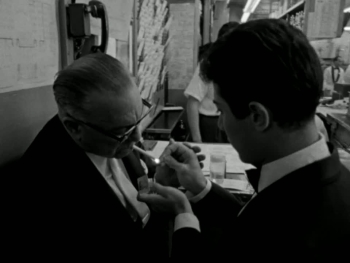
Paul doing some self-promotion at the Copacabana
That price is, of course, a central theme of the film. If the directors see Anka as a tragic figure, it is because the sacrifices he has made to get where he is seem to be very high. He has completely remade his physical appearance and allowed himself to be turned into a commodity trapped in a protective bubble, a puppet manipulated by his handlers. Still, listening to the interview where Anka describes his pre-show business self in terms which border on self-loathing, it is reasonable to assume that he would not consider the price to have been too high or see himself as a tragic figure. The real tragedy can be seen in retrospect. Like other characters in Canadian cinema, Anka left his hick town to hit the road to fulfill his dreams. As of the filming of Lonely Boy, he had not achieved them. He tells the camera that he doesn’t want a career that goes to a certain level, “but no further.” Being Paul Anka wasn’t good enough; he wanted to be Elvis Presley or Frank Sinatra. He did not know that he was then at his peak, that his career would be one that reached a certain level, but no further, and that in a couple of years the arrival of the Beatles would blow him out of the top tier of show business for good. He would certainly have successes after 1962. As a composer, he wrote the music for The Longest Day (1962), the theme song for the Johnny Carson-era Tonight Show and “She’s a Lady” (a hit for Tom Jones). He would take the French song “Comme d’habitude,” write English lyrics for it and turn it into the Sinatra anthem “My Way.” In the 1970s, he would have a comeback with three more top 10 hits. Most people would consider this a successful career, but it is a question whether the driven Anka of Lonely Boy, who had given up everything to make show business his life, would agree. Would he perhaps instead see himself as someone who, in the end, came up short?
Endnotes
1 Peter Harcourt. “The Canadian Cinema: The Years of Promise.” Movies & Mythologies. Toronto: CBC Publications, 1977, 138.
2 Greg Shaw. “The Teen Idols.” The Rolling Stone Illustrated History of Rock & Roll. Ed. Jim Miller. New York: Rolling Stone Press, Random House, 1976, 100.
3 About Paul Anka. 2009.
4 Shaw, Op cit, 96.
5 Harcourt, Op cit, 138.
6 Ibid, 140.
Bibliography
About Paul Anka. 2009.
Harcourt, Peter. “The Canadian Cinema: The Years of Promise.” Movies & Mythologies. Toronto: CBC Publications, 1977. 133-150.
Shaw, Greg. “The Teen Idols.” The Rolling Stone Illustrated History of Rock & Roll. Ed. Jim Miller. New York: Rolling Stone Press, Random House, 1976. 96-100.



